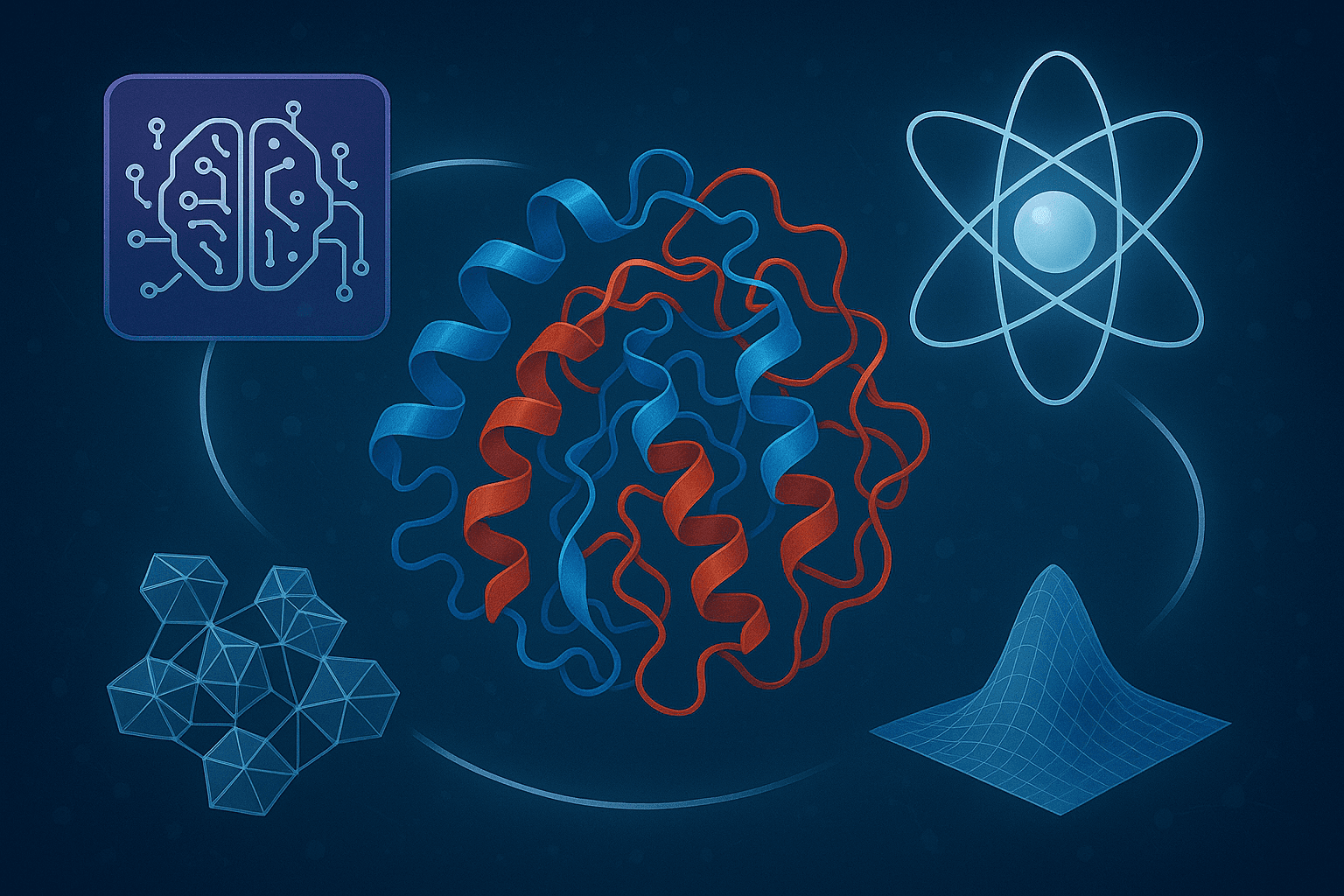AI-Driven Molecular Dynamics
Revolutionizing biomolecular simulation through the integration of artificial intelligence and quantum mechanical principles
Our research revolutionizes biomolecular dynamics simulation by developing AI-driven methods that achieve ab initio accuracy with unprecedented computational efficiency. We have created AI2BMD, the first artificial intelligence-based ab initio biomolecular dynamics system capable of simulating full-atom large biomolecules (>10,000 atoms) with quantum chemical accuracy while reducing computational time by several orders of magnitude compared to density functional theory.
Our approach combines protein fragmentation schemes with machine learning force fields to bridge the fundamental gap between fast classical molecular dynamics and accurate quantum chemistry methods. This enables exploration of protein conformational dynamics, folding processes, and thermodynamic properties with chemical accuracy at timescales previously impossible to achieve.
System Architecture
Comprehensive framework integrating artificial intelligence with quantum mechanical principles for accurate and efficient biomolecular simulation

The AI-driven molecular dynamics framework combines machine learning force fields with quantum mechanical calculations to achieve ab initio accuracy while maintaining computational efficiency for large biomolecular systems.
Key Research Areas
Revolutionary AI-based ab initio biomolecular dynamics system that enables full-atom simulation of large biomolecules (>10,000 atoms) with quantum chemical accuracy and orders of magnitude speedup.
- Protein fragmentation schemes
- Machine learning force fields
- Ab initio accuracy at classical speed
Comprehensive ab initio molecular dynamics datasets at density functional theory level, providing benchmarks for machine learning force field development and protein conformational space exploration.
- 2M conformations of 166-atom protein
- Folded, unfolded, and metastable states
- M06-2X/6-31G* level accuracy
Advanced metrics and methodologies for improving machine learning force fields, addressing generalization and robustness issues in molecular dynamics simulations.
- Fine-grained force metrics
- Element and conformation analysis
- Simulation stability assessment
Novel stochastic methods for robust Markov state model construction, enhancing the analysis of protein conformational dynamics and slow biological processes.
- Stochastic lag time parameterization
- Poisson process sampling
- Enhanced robustness for slow dynamics
Applications & Future Prospects
Our AI-driven molecular dynamics methods have transformative potential in understanding disease mechanisms and developing therapeutic interventions:
Drug Discovery
- - Accurate binding affinity prediction
- - Drug-target interaction mechanisms
- - Allosteric drug design
- - ADMET property prediction
Disease Understanding
- - Protein misfolding diseases
- - Cancer-related mutations
- - Neurodegenerative disorders
- - Metabolic pathway disruptions
Our research drives the development of next-generation computational tools and methodologies that push the boundaries of molecular simulation:
Speed Enhancement
1000x faster than traditional ab initio methods
Accuracy Preservation
Quantum-level accuracy with classical efficiency
Scale Extension
Simulating larger systems for longer timescales
Key Publications
Ab initio characterization of protein molecular dynamics with AI2BMD
Wang, T., He, X., Li, M., Li, Y., Bi, R., Wang, Y., Cheng, C., Shen, X., Meng, J., Zhang, H., Liu, H., Wang, Z., Li, S., Shao, B., & Liu, T. Y.
Innovation: First AI-based ab initio biomolecular dynamics system enabling full-atom simulation of large biomolecules (>10,000 atoms) with chemical accuracy using protein fragmentation and ML force fields
Contribution: Reduces computational time by several orders of magnitude compared to DFT while maintaining ab initio accuracy, enables nanosecond-scale protein dynamics with accurate 3J couplings matching NMR experiments
Impact: Enables precise free-energy calculations for protein folding, complements wet-lab experiments, and opens new possibilities for biomedical research previously impossible to conduct
AIMD-Chig: Exploring the conformational space of a 166-atom protein Chignolin with ab initio molecular dynamics
Wang, T., He, X., Li, M., Shao, B., & Liu, T. Y.
Innovation: First comprehensive DFT-level MD dataset for a real-world protein, containing 2 million conformations of 166-atom Chignolin sampled with 7.7M CPU hours at M06-2X/6-31G* level
Contribution: Covers complete conformational space including folded, unfolded, and metastable states, bringing DFT-level exploration from small molecules to proteins
Impact: Serves as benchmark for developing machine learning potentials for proteins and facilitates exploration of protein dynamics with ab initio accuracy
Improving machine learning force fields for molecular dynamics simulations with fine-grained force metrics
Wang, Z., Wu, H., Sun, L., He, X., Liu, Z., Shao, B., Wang, T., & Liu, T. Y.
Innovation: Systematic fine-grained force metrics from element and conformation aspects to measure MLFFs for every atom and conformation, addressing generalization and robustness issues
Contribution: Comprehensive evaluation of state-of-the-art MLFFs (ET, NequIP, ViSNet) on molecules ranging from 21-166 atoms, analyzing relationship between force metrics and simulation stability
Impact: Enables improved MLFF performance through guided training with force metrics as loss functions, fine-tuning, and recruiting additional unexplored data
Stochastic lag time parameterization for Markov state models of protein dynamics
Gong, S., He, X., Meng, Q., Ma, Z., Shao, B., Wang, T., & Liu, T. Y.
Innovation: Novel stochastic method using Poisson process to generate perturbative lag times for sub-trajectory sampling, replacing fixed lag time approach in MSM construction
Contribution: Significantly increases robustness and power of constructed MSMs without disturbing Markovian properties, validated on double-well system, WW domain, BPTI, and RBD-ACE2 complex
Impact: Superior performance amplified for slow dynamic modes in complex biological processes, enabling more robust protein dynamics analysis